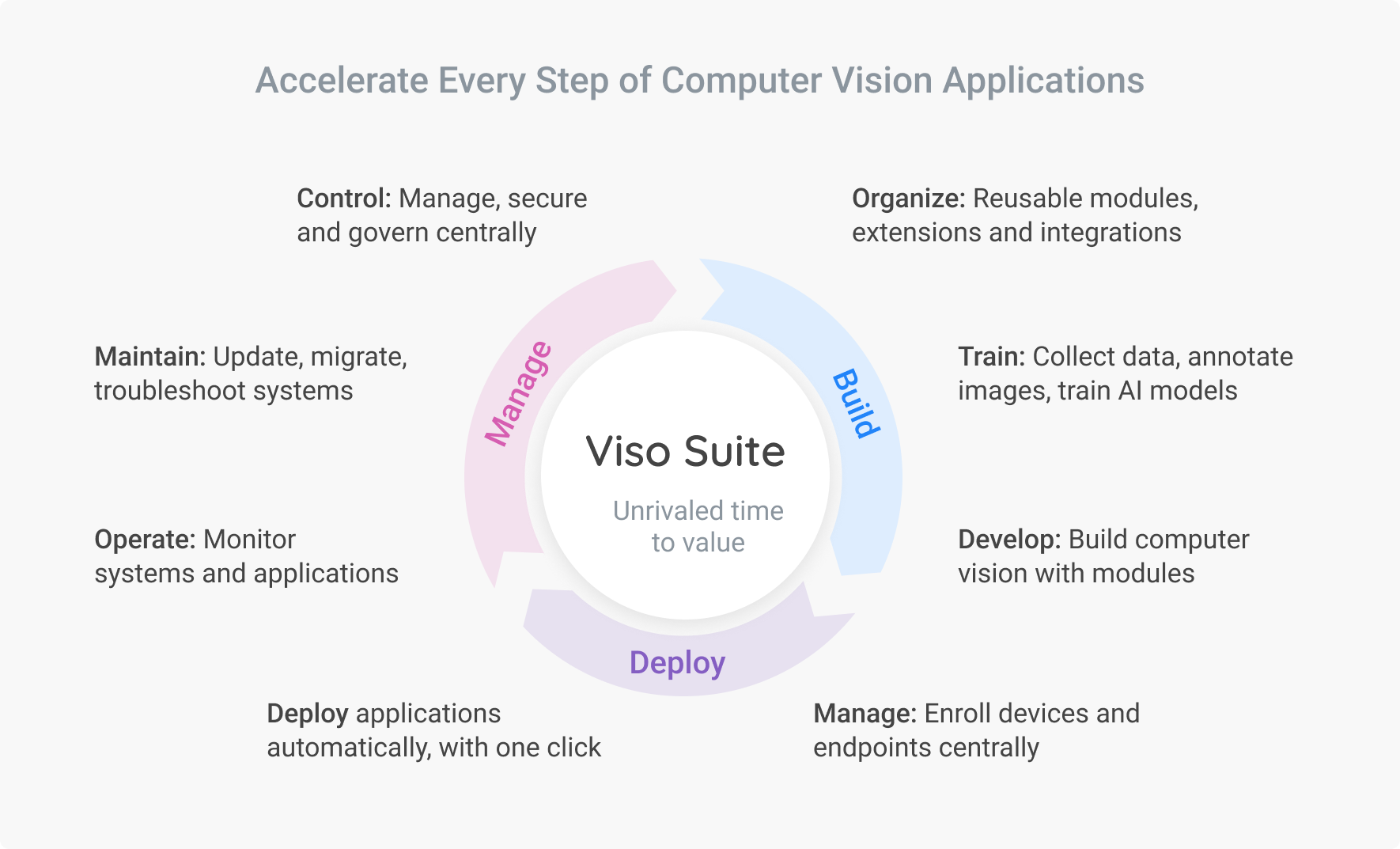Viso Suite is the only high-productivity computer vision platform for low-code application development that provides a comprehensive and integrated set of tools and services for managing the entire AI vision application lifecycle.
What is the computer vision application development life cycle?
The computer vision application development life cycle describes the process for planning, creating, testing, and deploying a computer vision system. The creation and maintenance of computer vision applications is required to create actual business value from AI models, by solving real-world problems and increasing efficiency through automation.
Viso Suite simplifies the full life cycle of computer vision applications
Viso Suite integrates and streamlines every step in the process and allows managing everything from one place: from data collection and image annotation for model training, to application development, deployment, operations, maintenance, and monitoring. This our customers to have very high success rates, achieve drastically lower total costs and establish better data security and governance across the entire process.
The Viso Suite workspace provides powerful no-code/low-code capabilities for collaboration, visual programming, image annotation, AI model management, device management, one-click deployments, remote troubleshooting, pre-built templates, extension library, as well as security and governance tools.
The seamless and highly automated tools eliminate traditional bottlenecks, integration roadblocks, costs, and risks that come with the delivery of computer vision applications. In parallel, increasing quality and better development experience for everyone involved in the application lifecycle.

Built-in AI vision application lifecycle capabilities
Viso Suite is the only high-productivity computer vision platform for low-code app development that provides a comprehensive and integrated set of tools and services for managing the entire app lifecycle.
- Collect Data. Collect image data to train your own custom AI model directly with the device and camera, which you can later use to run the application. Gather video data across multiple endpoints using any type of digital camera.
- Image Annotation. Annotate the collected or imported image data with best-in-class, automated image annotation tools. Label images and create training datasets to train your AI models.
- Manage AI Models. Manage an extensive list of state-of-the-art, pre-trained AI models along with your custom AI models in one place. You can use them to build different computer vision applications. Viso provides built-in version control and dependency management.
- Build Apps. Build and update applications with a visual editor. Wire together camera input with your AI models and pre-built modules. The application uses deep learning to turn real-time video input into insights. You can swap everything, for example, the AI model or hardware, with one click. This makes applications future-proof.
- Deploy Apps. Use one-click deployment to roll out applications across multiple endpoints such as edge devices (computers) or virtual endpoints. Code-building and deployment are fully automated, allowing to release new versions safely. You can build large distributed systems with hundreds of endpoints that are connected to one or multiple cameras.
- Manage Devices. Enroll and manage edge devices or virtual devices with a full device management system. You can automatically and securely enroll almost any computing device in your workspace. Use built-in tools to remotely access and troubleshoot endpoints.
- Monitoring. Monitor deployed applications with real-time dashboards and built-in health checks to automatically identify issues across all endpoints. Use the integrated BI tools and dashboard builder with pre-built widgets to visualize metrics in real-time.
- Security and Privacy. Protect critical systems and data with industry best practices. All data is encrypted at rest and in transit. Viso Suite provides role-based access control, a granular permission system, and custom user roles.